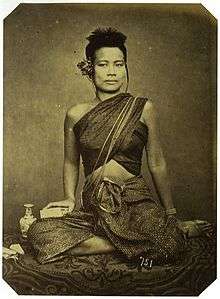Traditional Thai clothing

Traditional Thai attire are worn by men, women, and children, and consists of several elements.
Pha nung
It is like a sampot. The sampot (សំពត់, ALA-LC: saṃbát, IPA: [sɑmpʊət], pronounced sampaot) is a long, rectangular cloth worn around the lower body. It can be draped and folded in several different ways. The traditional dress is similar to the dhoti of southern Asia. It is also worn in the neighboring countries of Laos and Thailand where they are known as pha nung (ผ้านุ่ง).
Chong kraben
Chong kraben (Thai: โจงกระเบน Thai pronunciation: [tɕoːŋ.kràʔ.beːn]) is a lower-body, wrap-around cloth. Unlike the typical pha nung, it resembles pants more than skirts. It is a rectangular piece of cloth measuring 3 meters long and one meter wide. It is worn by wrapping around the waist, stretching it away from the body, twisting the ends together then pulling the twisted fabric between the legs and tucking it in the back of the waist.
Sinh

The sinh (Thai: ซิ่น Thai pronunciation: [sîn]) is a tube skirt which is worn by wrapping around the waist. A sin typically consists of three parts: hua sin, tua sin, and tin sin.
Sabai

Sabai (Thai: สไบ Thai pronunciation: [sa.baj]) or pha biang (Thai: ผ้าเบี่ยง Thai pronunciation: [pʰâː.bìaŋ]) is shawl-like garment, or breast cloth. Sabais can be used by women and men. Sabai is also known as a long piece of silk, about a foot wide, draped diagonally around the chest by covering one shoulder which its end drops behind the back.
Suea pat
Suea pat (Thai: เสื้อปัด Thai pronunciation: [sɯ̂a.pàt]) is a long-sleeved shirt with no buttons. It is worn by wrapping the right side of the front panel of the shirt over the left side of the front panel, and the two panels are tied together via strings. Suea pats are typically worn by northern Thai women
Formal Thai costume
The formal Thai costume, known in Thai as ชุดไทยพระราชนิยม (rtgs: chut thai phra ratcha niyom, literally Thai dress of royal endorsement), includes several sets of dress, designed as the Thai national costume in formal occasions. Although described and intended for use as national costume, they are of relatively modern origins, having been conceived in the second half of the 20th century.
See also
References
Further reading
- Conway, Susan, and Mūnnithi Čhēm ʻĒt Dapbœ̄nyū Thō̜msan. Power dressing: Lanna Shan Siam 19th century court dress. Bangkok: James H.W. Thompson Foundation, 2003.
- Conway, Susan. Thai textiles. London: British Museum Press, 1992.
- Lu, Sylvia. Handwoven textiles of South-East Asia. Singapore: Oxford University Press, 1988.
- Meanmas, Chavalit. Costumes in Asean. Thailand: The National ASEAN Committee on Culture and Information of Thailand, 2000.
- Wee, C. J. Wan. Local cultures and the "new Asia": the state, culture, and capitalism in Southeast Asia. Singapore: Institute of Southeast Asian Studies, 2002.
External links
- Traditional Thai Costumes
- Thai National Costume
- The Formal Thai National Costume
- Thai National Costume in Thailand